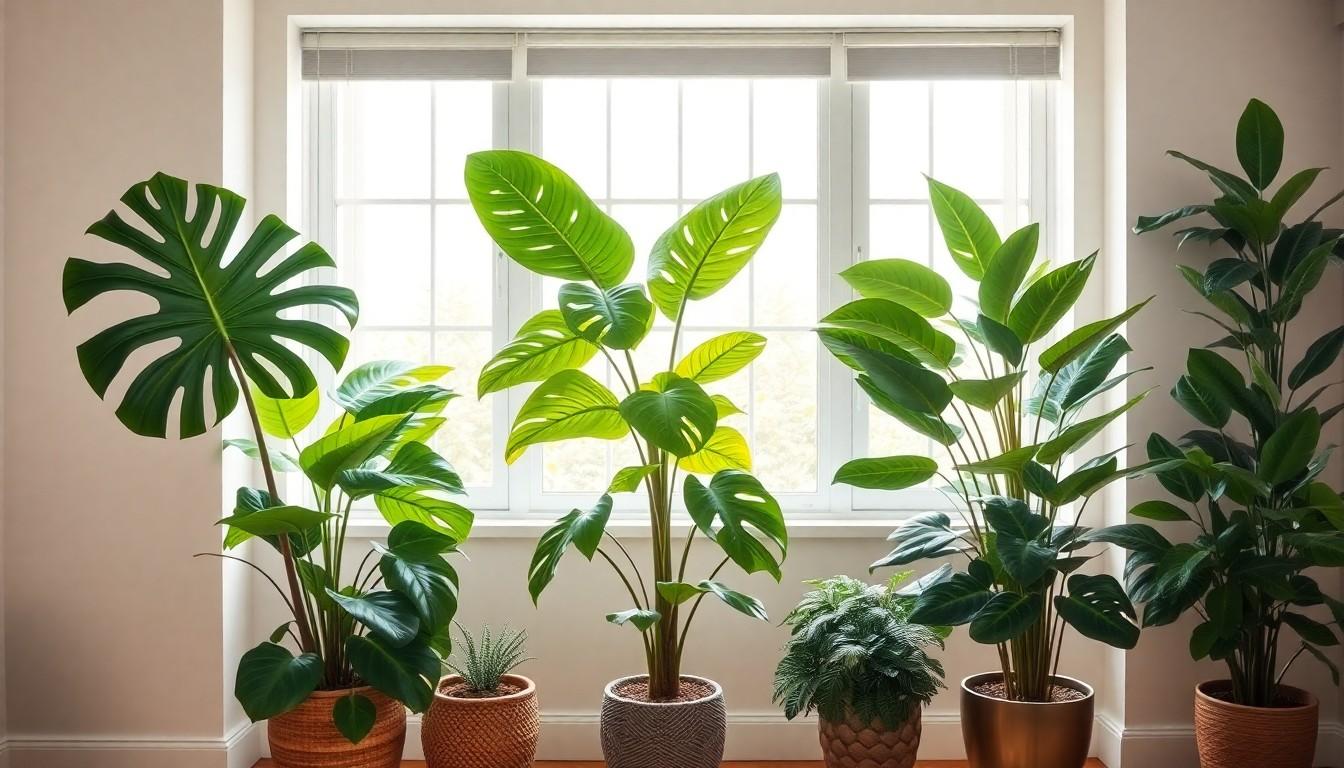Indoor plants with big leaves are the unsung heroes of home decor. They’re not just plants; they’re like the oversized celebrities of the botanical world, stealing the spotlight and demanding attention. Imagine walking into a room and being greeted by a lush, green giant that whispers, “I’m here to make your space fabulous.” Who wouldn’t want that kind of leafy drama?
Benefits Of Indoor Plants With Big Leaves
Indoor plants with big leaves provide significant advantages to any living space. They contribute positively to health, aesthetics, and overall well-being.
Air Purification
Big-leaved indoor plants excel in air purification. They filter pollutants and toxins such as formaldehyde and benzene, improving indoor air quality. Plants like the Peace Lily and Rubber Plant effectively absorb carbon dioxide, releasing oxygen. Increased oxygen levels can enhance concentration and promote better sleep. Improved air quality leads to well-being, making these plants critical for a healthier home environment.
Aesthetic Appeal
Large-leafed plants create stunning visual focal points. Their bold foliage adds depth and drama to room decor. Species like the Monstera Deliciosa and Fiddle Leaf Fig capture attention with unique shapes and vibrant colors. They complement various design styles, from modern to bohemian. Incorporating these plants into a space can elevate its overall look while promoting a serene, green atmosphere.
Popular Types Of Indoor Plants With Big Leaves

Indoor plants with big leaves create a vibrant aesthetic and enhance air quality. Several popular species stand out for their beauty and ease of care.
Monstera Deliciosa
Monstera Deliciosa, often called the Swiss Cheese Plant, features large, glossy leaves with unique splits and holes. This tropical plant thrives in indirect light but adapts to lower light conditions. Its distinctive appearance adds a bold statement to any space. Regular watering, ensuring the soil remains moist but not soggy, supports its growth. Ideal for beginners, it also promotes air purification.
Fiddle Leaf Fig
Fiddle Leaf Fig is well-known for its broad, glossy leaves that can grow up to 15 inches long. This plant prefers bright, indirect sunlight, making it ideal for well-lit rooms. Watering should occur only when the top inch of soil dries out to prevent root rot. Its striking silhouette complements modern decor styles and becomes a focal point in the room. This plant also benefits from occasional rotation to ensure even growth.
Rubber Plant
Rubber Plant, recognized for its large, thick leaves, can reach heights of up to 8 feet indoors. It thrives in bright, indirect light but can tolerate lower light levels over time. Watering once the top inch of soil feels dry encourages its robust growth. This plant’s rich green leaves bring a touch of elegance to any interior. Regular dusting of its leaves enhances its beauty and improves its ability to purify the air.
Care Tips For Growing Indoor Plants With Big Leaves
Indoor plants with big leaves require specific care for optimal growth. Understanding their needs promotes healthy development and enhances their striking appearance.
Light Requirements
Light conditions significantly influence the growth of large-leafed plants. Many thrive in bright, indirect sunlight, which prevents leaf burn while ensuring adequate energy for photosynthesis. The Monstera Deliciosa prefers filtered light, whereas the Fiddle Leaf Fig flourishes in bright, diffused light. Low-light settings can hinder growth, leading to leggy plants. By placing these plants near east or west-facing windows, owners can provide ideal light exposure while avoiding direct sunlight during peak hours.
Watering Guidelines
Watering practices play a crucial role in maintaining healthy large-leafed plants. Overwatering can lead to root rot, so it is essential to allow the top inch of soil to dry out before rewatering. The Rubber Plant prefers a dryer environment compared to others and can tolerate periods of drought. During the growing season, watering every one to two weeks usually suffices, reducing frequency in winter months when growth slows down. Checking the soil moisture regularly ensures plants receive adequate hydration while preventing waterlogged conditions.
Soil Recommendations
Soil quality greatly affects the health of indoor plants with large leaves. Well-draining potting mixes are ideal, allowing excess moisture to escape while retaining necessary nutrients. A mixture of potting soil, peat moss, and perlite promotes drainage and aeration, supporting root development. These plants often appreciate slightly acidic to neutral soil, with a pH range of 6 to 7. Regularly refreshing the soil every year or so aids in providing essential nutrients, ensuring vibrant foliage and robust growth.
Common Pests And Problems
Indoor plants with big leaves face several pest challenges and problems. Identifying these pests early helps maintain plant health.
Identifying Pests
Common pests include spider mites, aphids, and mealybugs. Spider mites create fine webbing on leaves, signaling a problem. Aphids appear as small, soft-bodied insects that cluster on new growth. Mealybugs leave cottony white masses on stems and leaves. Regularly checking the undersides of leaves allows for early detection. Signs of damage such as discolored or wilting leaves indicate potential pest infestations. Noticing sticky residue, known as honeydew, may also suggest an aphid problem. Understanding these signs aids in protecting large-leafed plants.
Preventive Measures
Preventive measures significantly reduce pest infestations. Maintaining optimal humidity levels for plants helps prevent spider mite outbreaks. Regularly cleaning leaves removes dust and debris, promoting healthier plants. Inspecting new plants before introducing them to the home prevents introducing pests. Using insecticidal soap or neem oil offers a natural approach to pest control. Rotating indoor plants encourages even exposure to light, promoting overall health. Proper spacing between plants improves air circulation, reducing the risk of pests. Taking these steps fosters healthier indoor environments for big-leaved plants.
Conclusion
Indoor plants with big leaves are more than just decorative elements; they’re vital contributors to a healthier living space. Their unique aesthetics and air-purifying qualities make them a perfect choice for anyone looking to enhance their home environment. By selecting species like the Monstera Deliciosa or Fiddle Leaf Fig, individuals can add a touch of nature that complements various design styles.
Proper care is essential for these plants to thrive. Understanding their light and watering needs ensures vibrant foliage and robust growth. With a little attention to detail, these oversized green companions can flourish, transforming any room into a serene oasis. Embracing large-leafed plants not only beautifies a home but also promotes well-being, making them a worthy addition to any indoor space.





